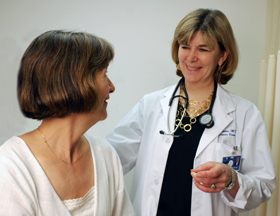Feature Story
Health Center Today, October 22, 2010
NASA Technology May Improve Ability to Analyze Mammograms
By Maureen McGuire

Dr. Molly Brewer with a patient.
NASA recently announced that an innovative software program originally developed to enhance imagery of Earth could also help analyze mammograms, ultrasounds, digital X-rays and other medical imaging tests.
The technology caught the attention of Dr. Molly Brewer, director of both the Division of Gynecologic Oncology and the Women’s Cancer Prevention Program, who is interested in pursuing clinical research with this system.
"One problem with mammograms is they often give a false negative for detecting abnormalities in women's breasts," Brewer said during a teleconference with NASA during Breast Cancer Awareness Month.
"Women who either have high breast density or a strong family history of breast cancer are often sent for MRIs, which are costly, very uncomfortable and have a high false positive rate resulting in many unnecessary biopsies. The new system allows a doctor to see a lot more detail from the mammogram – and could save patients money and anxiety by reducing the number of costly and unnecessary tests."
According to NASA, the Food and Drug Administration recently cleared the system for trained professionals to process images. These images can be used in radiologists' reports and communications, but the processed images should not be used for primary diagnosis.
The core of MED-SEG system is a computer algorithm, the Hierarchical Segmentation Software, developed at NASA's Goddard Space Flight Center in Greenbelt, Md., by computer engineer James C. Tilton.
His goal was to advance a totally new approach for analyzing digital images, which are made up of thousands of pixels. Like a single piece of a jigsaw puzzle, a pixel often does not provide enough information about where it fits in the overall scene. To overcome the deficiency, Tilton focused on an approach called image segmentation, which organizes and groups an image's pixels together at different levels of detail. Tilton's approach to image segmentation is different than others. It finds region objects, and also groups spatially separated region objects together into region classes.
For example, an Earth satellite image may contain several lakes of different depths. Deep lakes appear dark blue, and shallow lakes are a lighter shade of blue. The software first finds each individual lake; then it groups together all shallow lakes into one class and the deeper lakes into another. Because lakes are more similar than they are to vegetation, roads, buildings, and other objects, the software groups all lakes together, regardless of their varying colors. As a result, the software allows the user to distinguish important features in the scene accurately and quickly.
For more information, visit: http://ipp.gsfc.nasa.gov.


